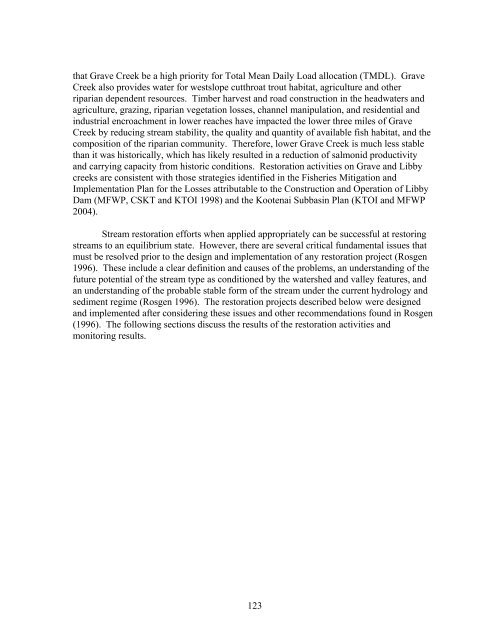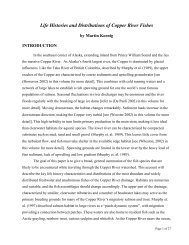Mitigation for the Construction and Operation of Libby Dam
Mitigation for the Construction and Operation of Libby Dam
Mitigation for the Construction and Operation of Libby Dam
Create successful ePaper yourself
Turn your PDF publications into a flip-book with our unique Google optimized e-Paper software.
that Grave Creek be a high priority <strong>for</strong> Total Mean Daily Load allocation (TMDL). Grave<br />
Creek also provides water <strong>for</strong> westslope cutthroat trout habitat, agriculture <strong>and</strong> o<strong>the</strong>r<br />
riparian dependent resources. Timber harvest <strong>and</strong> road construction in <strong>the</strong> headwaters <strong>and</strong><br />
agriculture, grazing, riparian vegetation losses, channel manipulation, <strong>and</strong> residential <strong>and</strong><br />
industrial encroachment in lower reaches have impacted <strong>the</strong> lower three miles <strong>of</strong> Grave<br />
Creek by reducing stream stability, <strong>the</strong> quality <strong>and</strong> quantity <strong>of</strong> available fish habitat, <strong>and</strong> <strong>the</strong><br />
composition <strong>of</strong> <strong>the</strong> riparian community. There<strong>for</strong>e, lower Grave Creek is much less stable<br />
than it was historically, which has likely resulted in a reduction <strong>of</strong> salmonid productivity<br />
<strong>and</strong> carrying capacity from historic conditions. Restoration activities on Grave <strong>and</strong> <strong>Libby</strong><br />
creeks are consistent with those strategies identified in <strong>the</strong> Fisheries <strong>Mitigation</strong> <strong>and</strong><br />
Implementation Plan <strong>for</strong> <strong>the</strong> Losses attributable to <strong>the</strong> <strong>Construction</strong> <strong>and</strong> <strong>Operation</strong> <strong>of</strong> <strong>Libby</strong><br />
<strong>Dam</strong> (MFWP, CSKT <strong>and</strong> KTOI 1998) <strong>and</strong> <strong>the</strong> Kootenai Subbasin Plan (KTOI <strong>and</strong> MFWP<br />
2004).<br />
Stream restoration ef<strong>for</strong>ts when applied appropriately can be successful at restoring<br />
streams to an equilibrium state. However, <strong>the</strong>re are several critical fundamental issues that<br />
must be resolved prior to <strong>the</strong> design <strong>and</strong> implementation <strong>of</strong> any restoration project (Rosgen<br />
1996). These include a clear definition <strong>and</strong> causes <strong>of</strong> <strong>the</strong> problems, an underst<strong>and</strong>ing <strong>of</strong> <strong>the</strong><br />
future potential <strong>of</strong> <strong>the</strong> stream type as conditioned by <strong>the</strong> watershed <strong>and</strong> valley features, <strong>and</strong><br />
an underst<strong>and</strong>ing <strong>of</strong> <strong>the</strong> probable stable <strong>for</strong>m <strong>of</strong> <strong>the</strong> stream under <strong>the</strong> current hydrology <strong>and</strong><br />
sediment regime (Rosgen 1996). The restoration projects described below were designed<br />
<strong>and</strong> implemented after considering <strong>the</strong>se issues <strong>and</strong> o<strong>the</strong>r recommendations found in Rosgen<br />
(1996). The following sections discuss <strong>the</strong> results <strong>of</strong> <strong>the</strong> restoration activities <strong>and</strong><br />
monitoring results.<br />
123
















